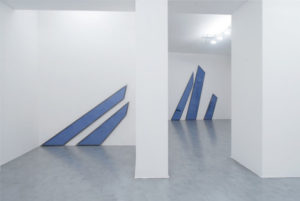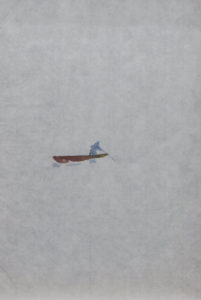In the Greek mythology Mnemosyne (Memory) is an Olympic godhead daughter of Uranus (Heaven) and Gaia (Earth): her union with Zeus gave birth to the Muses, goddesses of music and dance who celebrated with their verses the origin the world and gods and men’s deeds. Drawing upon the classical suggestions Aby Warburg in 1929 entitled Mnemosyne his last large achievement: a figurative atlas illustrating the tradition of themes and figures from ancient to current times through the editing of photographs of Renaissance works, classical and twentieth century. The photographic reproductions, taken from the endless archive to which the historian drew to accompany his writings and his lectures, were assembled into thematic sections that reset every form of temporal and geographical hierarchy and reactivated the eloquence and expressive power of the original works. The images, demons of pure communicative potential and main vehicles and supports for the cultural and social memory, survive their time to be witness and continue to unleash their primal power of evocation when they are left free to provoke an open interpretative process. So the images of the past, as Georges Didi-Huberman wrote, are always ready to rise up in the present, to burn and to suffer at the point where it becomes more lacerating the gap between detachment and belonging to the reality that generated them.
These reflections are linked to Time Geographies by Sophie Ko Chkhejdze, a young Georgian artist who focuses her most recent and intense series of works in the ontological and poetic investigation of the image concept understood as resistance to an irrepressible desire to figuration by which humanity preserves and passes on its ancestral inheritance. In the age of instant news and pervasive as ephemeral ubiquity of visual surrogates of reality conveyed by the network and by other mass media, the project questions the permanence of the expressive value of images penetrating the unspeakable instinctual tangle that binds the human spirit to the material layers that make up the work. Returning to artistic action its ancient ritual implications and interpreting in a radical way the insights of Warburg and Didi-Huberman, Ko realizes her paintings imprisoning between glass panels the ash generated by the burning of images of famous works of history art along with powders of pure pigment. Symbolically this vacuum space manages to condense the form and content of past and present civilizations in a higher existential unity that goes beyond the succession of stylistic adventures to give itself as the essence of a mystery still to be accomplished. Intimately aware of her responsibility towards the great masters, the artist instead of seeking her own autonomous language within an archive of forms filed in a partial and unbalanced historical memory, chooses the primordial undifferentiated to awaken the deepest reasons of creating.
Silently the invisible corporeal dust thickens into craters, emergencies and highlands that evoke the inescapable geological processes of an unexplored continent or the expansion of unknown galaxies next to collapse. When the force of gravity or a change in humidity make dust crumble down, the gray ash betrays precious veins and glows of volatile pigments that regenerate its soul. You have to gently blow on the ashes so that the end turns into a new beginning and the brace start again to give off its heat while the time in the absence of external forces finds its true measure in the harmony of leisure and meditation. Once again, earth and sky come together to form the passage of time transforming its duration in the weight of a subtle and changeable matter destined to an eternal cycle of rebirth and destruction. If the images that appear behind the glass are intended to be consumed in a slow erosion and precipitation, their remains will create other visions that they will pass on their material memory the impression of the previous combinations. In her powder devices the artist overturns the hourglass metaphor, which in Vanitas refers to the short time given to each one, showing how the irreversible consumption of each image is a prerequisite for a new epiphany and an additional acquisition of meaning. Memento vivere! Therefore the paintings by Sophie Ko seem to admonish into a powerful mission statement that emphasizes the importance and vitality of the artistic process as an inexhaustible source of wonder and awareness. If the unburned remains of the burned images regenerate their figurative potential preserving intact their aura and bring back the artistic manifestations of the past to their undifferentiated original matrix, it also includes that glass structures containing powders are anything but inert. The shapes of the glass cases vary from simple rectangles and squares that recall the inrush of minimalism and abstraction in the history of the forms to more complex irregular polygons that somehow embody the dissolving of their rigor towards a return of figuration. So the color gradations in rectangular field of Time Geographies incorporate the sophisticated investigations on pure color of certain conceptual painting, the square of Man lit himself a light in the night relates to an austere twentieth century frame, while the white Atlases rushes upward as sharp sidereal romantic or expressionistic cliffs. Even here the references spontaneously crop up without wanting to be quote or dissertation and the unprecedented flexibility of their unobtrusive presence blends with artistic deposits that lie in the apparent stillness of ashes.
Multiple and unique at the same time, paintings by Sophie Ko are revealed as mythological places of gestation and reconciliation of ancestral tensions and differences: brittle/rigid, transparent/opaque, painting/sculpture,antique/contemporary, abstraction/figuration, whole/fragmented, modular/corpuscular and other oppositional categories cease to counteract each another to converge in a unit scope.
Sophie Ko. Earth.
curated by Federico Ferrari
Galleria de’ Foscherari
Via Castiglione 2 Bologna
 Sophie Ko, Atlanti, courtesy Galleria de’ Foscherari
Sophie Ko, Atlanti, courtesy Galleria de’ Foscherari
 Sophie Ko, Geografie Temporali, courtesy Galleria de’ Foscherari
Sophie Ko, Geografie Temporali, courtesy Galleria de’ Foscherari
 Sophie Ko, Geografie Temporali, courtesy Galleria de’ Foscherari
Sophie Ko, Geografie Temporali, courtesy Galleria de’ Foscherari
 Sophie Ko, Kaspar Hauser, courtesy Galleria de’ Foscherari
Sophie Ko, Kaspar Hauser, courtesy Galleria de’ Foscherari
Graduated in art history at DAMS in Bologna, city where she continued to live and work, she specialized in Siena with Enrico Crispolti. Curious and attentive to the becoming of the contemporary, she believes in the power of art to make life more interesting and she loves to explore its latest trends through dialogue with artists, curators and gallery owners. She considers writing a form of reasoning and analysis that reconstructs the connection between the artist’s creative path and the surrounding context.







NO COMMENT